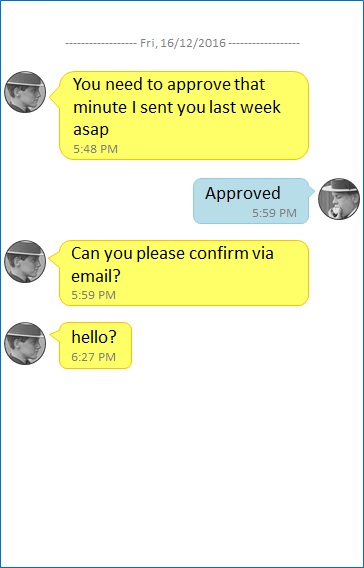You don’t gotta catch ’em all: managing text messages for business December 22, 2016
 We recently published new advice on managing text messages as records. It provides guidance on how you can capture text messages into your corporate recordkeeping system. It is, however, only half of the conversation – and the second half at that. Before we jump into managing text messages as records, we need to think about how we’re using text messages, what evidence we need to record, and the best way to record it.
We recently published new advice on managing text messages as records. It provides guidance on how you can capture text messages into your corporate recordkeeping system. It is, however, only half of the conversation – and the second half at that. Before we jump into managing text messages as records, we need to think about how we’re using text messages, what evidence we need to record, and the best way to record it.
The NSW Government has done exceptional work to facilitate a mobile workforce. For those with the will, the NSW Government has certainly paved the way with resources such as the BYOD Policy Toolkit. While many agencies will have capitalised on the flexibility this provides, we are still a way away from being peak mobile – at least in a business sense. For office-based work, work-issued mobile devices are often limited to senior managers. Mobile devices enable them to remain contactable and responsive wherever they are.
When it comes to conducting official business, are your agency guidelines clear? Our advice on managing text messages outlines some of the limitations of relying on text messages as records of continuing value. An email, equally accessible on a smart phone, is easier to capture and manage as a record, both in terms of content and metadata. If you prefer to manage records from mobile devices as emails, then it is important that your staff know which mobile communications should be sent as emails, and which can be sent as text messages.
Managing records or managing behaviour
Using a text message instead of an email might afford the user a small efficiency gain while sending or receiving the initial message. However, in most cases this will be eclipsed by the effort taken to translate that message into an appropriate record if it becomes necessary to do so.
‘Low-tech’ measures such as transcription or capturing screenshots have some clear disadvantages. The manual input, or ‘automation gap’, creates an opportunity for error or mischief. Depending on how important the communication is, this risk may be unacceptable. But more importantly, in order to be at all effective these methods rely on significant additional user action. If you can’t persuade someone to send an email, you aren’t likely to do better telling them to take a screen shot of their phone and emailing that instead. These solutions should generally be taken as measures of last resort.
The preferable option is to establish clear policy guidelines about when it is acceptable to use a text message. For example:
- Confirming short-term arrangements (e.g. taxi ready at 5pm)
- Alerts and notifications (e.g. check your email)
- With compliments (e.g. thanks for taking the time to meet)
- Reasonable personal use for non-work matters (e.g. please buy milk)
These types of communications are short-term or ephemeral and capturing them all would have little value. Give your staff the confidence to destroy them as a normal administrative practice. For communications with continuing value to your business, it is better to use a more robust communications platform such as email.
Implementing records management policies and crafting behaviour can be challenging. If you need any help or advice, or would like to share your experience, please get in touch with us (by email, of course).
Image credit: Extract from SARANSW: NRS 4481, Boys eating from same piece of fruit, “bite for bite”


Leave a Reply
You must be logged in to post a comment.